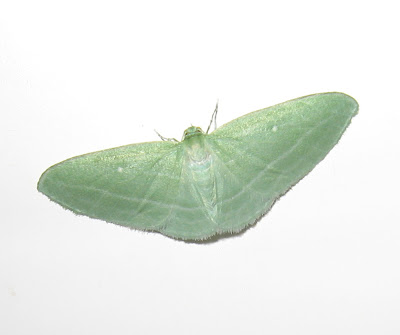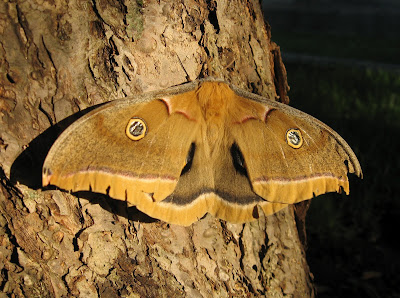The origin or etymology of this turn of speech describing a group of moths is, no pun intended, obscure. Perhaps its origins can be attributed to the dull, cryptic coloration of many moth species, but eclipse is the last word that comes to mind when one encounters moths which use color to attract a mate visually, or sport eyes-spots or other startle patterns, or are toxic or distasteful and display aposematic colors to advertise their unpalatability.
Hiding in plain sight ... oddly enough, the eye-catching pink wings of the Primrose Moth (Schinia florida) actually seem to help it blend into the background. It was surprisingly difficult to pick out these moths nectaring at their favorite flower, which also serves as the larval host plant.
Tiger Moths, Lichen Moths and other members of the subfamily Arctiinae are often day fliers and tend to be quite colorful. An interesting characteristic of this group of moths is family is a tymbal organ on the metathorax, thought to be a sonic countermeasure against bat's echolocation systems.
Aposematic ... from Greek, apo → away, and sematic → sign or meaning.
The feathery antenna indicate this is a male Virginia Ctenucha (Ctenucha virginica) ...
... often confused with the Yellow-collared Scape Moth (Cisseps fulvicollis). Here's a link to the
Cisseps fulvicollis page at BugGuide.Net. Good information, but it doesn't answer a question that's been "bugging" me – are the clashing colors a Batesian bluff, or an aposematic alert? The moths' vivid orange and iridescent blue paint job (and manner of flight) does impart a wasp-like aspect ... or ... is it meant to tell hungry eyes "I'm poisonous!"?
The bold colors of the Black-and-yellow Lichen Moth (Lycomorpha pholus) are presumed to mimic the distasteful Net-winged Beetles (family Lycidae).
To be sure, the Lichen Moth is a pretty good facsimile of the End-Banded Net-Winged Beetle (Calopteron terminale). But I am puzzled ... my understanding is that in order for Batesian mimicry to be successful, the population of models (in this case the Net-winged Beetle) must be greater than the number of mimics (Lichen Moth). Yet from what I have observed, there are a lot more Lichen Moths than Net-winged Beetles out there ...
Caterpillars of the brilliant Scarlet-Winged Lichen Moth (Hypoprepia miniata) feed on lichens living on trees. Judging by its colors this moth must be either noxious or its flavour leaves something to be desired. Are the toxins manufactured by the adult moth, or does it sequester them as a larva?
There are several species of Grammia with similar markings; I think this one is an Anna Tiger Moth (Grammia anna). Thus far I've been unable to find a theory or an explanation as to the reason for the strongly contrasting, albeit aesthetically pleasing, geometric patterns.
Do the contrasting reds and blues of the Squash Vine Borer (Melittia cucurbitae) mean it's toxic? Or is this moth meant to resemble a wasp like many other Clearwing Moths belonging to the family Sesiidae?
It would seem that the much more somber adult moth lacks the caterpillar's chemical defenses.
A pleasingly patterned Spotted Tussock Moth (Lophocampa maculata) perching on an Interrupted Fern frond.
One of the giants of the local moth world, the Polyphemus Moth (Antheraea polyphemus). The wingspan doesn't quite measure up to that of a
Cecropia Moth, but it's close ...
The prominent purplish eyespots on the hindwings are thought to be a distraction display, startling a would-be predator for a vital fraction of a second and giving the moth a chance to escape.
The cryptic markings of a beautifully patterned Waved Sphinx (Ceratomia undulosa) serve well when it's perching on a tree trunk, but do little to hide it against the background of a brick wall. Not to mention its size ... with its robust cigar-shaped body and roughly 100 mm wingspan, the moth stands out like a sore thumb.
Look-alike, or almost look-alike, leps – the Eight-spotted Forester (Alypia octomaculata) ...
... and the White-spotted Sable Moth (Anania funebris). There are differences between the two species; the legs of the Eight-spotted Forester bear yellow tufts, and the patches on each side of the thorax of the White-spotted Sable Moth are yellow rather than white. Also (this is obvious when seeing the moths in the field, not a photograph) the wingspan of the Eight-spotted Forester is about 35 mm, that of the White-spotted Sable Moth is only around 20 mm.
So – how does all this decoration serve the ultimate goal of increasing the moths' chances of survival? Are the conspicuously spotted wings of these insects a coincidence, is one moth mimicking the other, or are both imitating a third distasteful insect species?

The wary, difficult to approach White-striped Black (Trichodezia albovittata) has a distinctive, butterfly-like manner of flight, and this little moth never seems to stop for a rest. Again, it strikes me as odd that this moth seems to attract attention to itself – despite its small size (the wingspan is roughly 20 mm) it certainly stands out when in flight and even continues to move its wings up and down, like a butterfly, when perching. What's the benefit or advantage of the bold markings?
Last but not least, a Geranium Plume Moth (Amblyptilia pica), easily mistaken for a piece of dried plant debris as it takes a rest on a thistle.
So much yet to learn about such a simple thing as the reason for the myriad variety of patterns and colors in a moth's wings! Biologists and scientists in general certainly have their work cut out for them in unlocking the mysteries of our natural world, and, as always, every answer will spawn a dozen new questions, but that's what makes science so much fun. In the meantime, areas of knowledge will remain hidden from our view – "eclipsed", figuratively speaking ...





























































